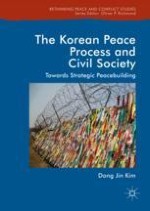2019 | OriginalPaper | Buchkapitel
3. The Korean Conflict and Society: A Historical Context
verfasst von : Dong Jin Kim
Erschienen in: The Korean Peace Process and Civil Society
Aktivieren Sie unsere intelligente Suche, um passende Fachinhalte oder Patente zu finden.
Wählen Sie Textabschnitte aus um mit Künstlicher Intelligenz passenden Patente zu finden. powered by
Markieren Sie Textabschnitte, um KI-gestützt weitere passende Inhalte zu finden. powered by
